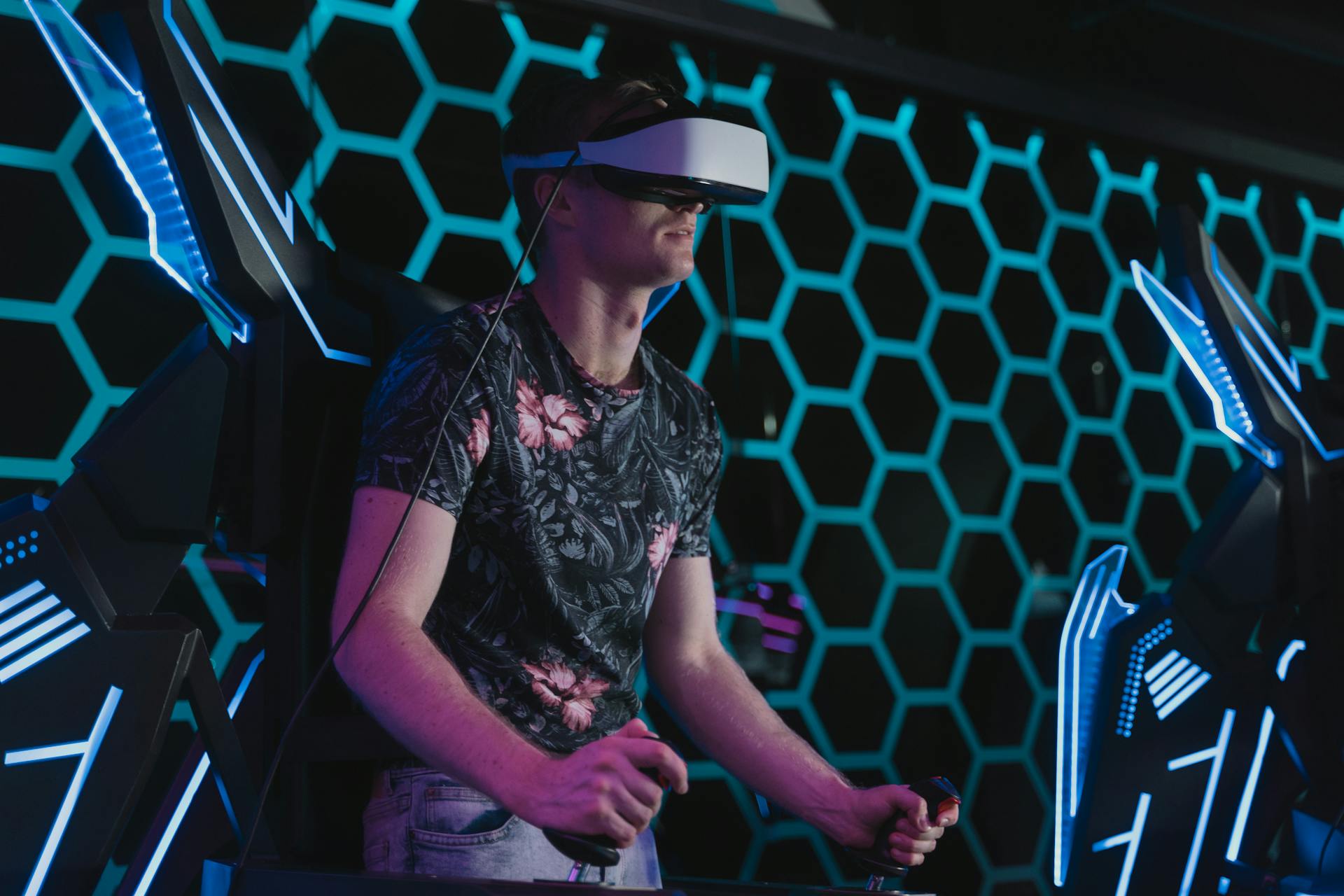
Artificial intelligence in game development has come a long way, from its humble beginnings in the 1950s to the sophisticated systems we see today.
The first AI-powered game, "Tic-Tac-Toe", was developed in 1952 by computer scientist Alexander S. Douglas. This early game used a simple decision tree to determine the best move.
In the 1970s and 1980s, AI in games started to gain traction, with the introduction of rule-based expert systems. These systems allowed for more complex decision-making, but were still limited in their ability to adapt to changing situations.
The 1990s saw a significant leap forward with the introduction of machine learning algorithms, which enabled games to learn from player behavior and adapt to new situations.
Additional reading: Training an Ai in Game
What Is AI in Game Dev
AI in game development refers to a broad set of algorithms that include techniques from control theory, robotics, computer graphics, and computer science.
Game AI has revolutionized the way humans interact with technology, but many expert researchers are skeptical of its true potential.
Game AI is often not considered "true AI" because it doesn't facilitate computer learning or other standard criteria, but rather constitutes "automated computation" or a predetermined set of responses to a limited set of inputs.
Industry voices argue that AI has become more versatile in the way we use technology, allowing it to operate in multiple ways and even develop its own personality.
However, some people in the field of AI see game AI as an advertising buzzword that creates the illusion of intelligent behavior using simple sorting and matching algorithms.
Games have provided an environment for developing artificial intelligence with potential applications beyond gameplay, such as the development of Watson, a Jeopardy!-playing computer.
Expand your knowledge: Learn How to Code Tetris Game Python
History and Evolution
The journey of AI in game development is a story of gradual improvement. Early video games like Pac-Man and Space Invaders used simplistic AI for pathfinding, which navigated characters and enemies through digital mazes.
These early pathfinding algorithms laid the groundwork for the evolution of AI in the industry. As technology advanced, game AI became more complex and capable.
The introduction of more sophisticated decision-making algorithms allowed for the creation of Non-Player Characters (NPCs) that could perform a wider range of actions and react to player behavior.
History

The journey of AI in game development has been a gradual one, starting with simple pathfinding algorithms in early titles like "Pac-Man" and "Space Invaders".
These early AI systems were rudimentary yet effective, providing a semblance of challenge and unpredictability within the constraints of the era's technology.
As technology advanced, so did the complexity and capability of game AI, allowing for the creation of Non-Player Characters (NPCs) that could perform a wider range of actions.
Games like "The Sims" showcased AI that simulated complex social interactions and life-like behaviors, marking a significant leap from the straightforward, predictably patterned AI of previous generations.
The introduction of more sophisticated decision-making algorithms was a key factor in the evolution of game AI, enabling NPCs to react to player behavior and make decisions based on predefined conditions.
These advancements paved the way for the creation of more realistic and engaging game worlds, where players could interact with characters that seemed almost human.
Breakthroughs in Technology
The recent era has witnessed groundbreaking strides in AI technology, catapulting its potential in game development to unprecedented heights. Machine learning and neural networks have emerged as game-changers, enabling AI to learn from data, adapt to player actions, and generate content in ways that were previously unimaginable.
Deep Learning, a subset of machine learning, has demonstrated remarkable success in various domains, including natural language processing, image recognition, and procedural content generation and sophisticated NPC behavior modeling.
The advent of Generative Adversarial Networks (GANs) allows for the creation of complex, varied game environments and assets, showcasing a level of detail and diversity that manual design methods would struggle to achieve.
Reinforcement learning has paved the way for dynamic difficulty adjustment systems and smarter, more autonomous NPC behavior. By employing a system of rewards and penalties, AI can optimize its strategies in real-time, offering players a more personalized and challenging experience.
The integration of these cutting-edge AI technologies into game development is not merely an enhancement of existing paradigms but a redefinition of how games are conceptualized, designed, and experienced.
Intriguing read: Machine Intelligent
Types of AI in Games
AI in games can be used for image enhancement, making graphics look smoother and more realistic.
Automated level generation is another application, allowing game developers to create a vast number of levels with varying difficulty.
Balancing in-game complexity is also a key aspect, ensuring that the game remains challenging but not frustratingly difficult.
Adding intelligence to non-playing characters (NPCs) is a crucial aspect of AI in games, making them behave more realistically and interact with players in a more believable way.
Computer Board Simulations
Computer board simulations are a fascinating area of AI research. They involve creating computer programs that can play and simulate various board games.
Computer chess is a well-known example of this, with computers able to play at a level that rivals human grandmasters. Some computer chess programs can even anticipate and respond to human moves.
Computer simulations have also been applied to other board games like Go, where computers can play at a level that is considered unbeatable. In fact, computer Go players have been known to force a win or draw in some games.
Here's a list of some other board games that have been simulated by computers:
- Computer shogi
- Computer checkers
- Computer Othello
- Computer Arimaa
- Logistello, which plays Reversi
- Rog-O-Matic, which plays Rogue
- Computer players of Scrabble
These simulations have led to significant advancements in AI research, particularly in the area of general game playing.
Monte Carlo Tree Search
Monte Carlo Tree Search is a method used in game AI to create a more engaging experience for players. This is achieved by introducing additional obstacles for the player to overcome.
The MCTS method involves creating a tree diagram, similar to playing tic-tac-toe, where the AI selects a pathway based on the outcome. This allows the AI to come up with strategies to surpass the obstacle.
Game AI often relies on pathfinding and finite state machines to navigate the game world. However, MCTS provides a more dynamic approach by introducing obstacles and challenges for the player.
In complex video games, these tree diagrams can have many branches, reflecting the player's ability to come up with multiple strategies to overcome the obstacle.
Forza Horizon Series
The Forza Horizon Series is a simulation racing game that emulates real-world racing car performance and handling characteristics.
The game employs a learning neural network in its design to control non-human drivers, allowing it to observe human drivers and imitate their style of driving.
This AI system is known as Drivatar and has been connected to Microsoft's cloud services, providing it with driving data from a vast number of human racers.
The data is used to create AI systems that mimic other players from around the world, including their strengths and weaknesses, to provide unpredictable experiences for competing human drivers.
AI in Game Mechanics
AI in game mechanics is a rapidly evolving field, where machine learning algorithms are being used to create more realistic and engaging gameplay experiences.
Procedural generation, a technique that uses algorithms to create content on the fly, has been a key area of focus in AI-powered game development. This approach allows for nearly endless variety in game worlds and levels.
By leveraging machine learning, game developers can create more dynamic and responsive gameplay mechanics, such as adaptive difficulty levels that adjust to the player's skill level.
Consider reading: Intelligent Harmony Machine
Procedural Content
Procedural content generation is a game-changer in the world of game design. It allows developers to create unique and diverse game content with minimal input from designers, resulting in reduced development time and costs.
Procedural content generation can be used to dynamically generate game features such as levels, NPC dialogue, and sounds. This technique is particularly useful in creating massive repositories of levels from data sets, as seen in the 2023 study where researchers trained a large language model to generate levels in the style of the 1981 puzzle game Sokoban.
Games like Minecraft and No Man's Sky have successfully implemented procedural content generation to create vast, diverse game worlds that can surprise players with their variability. No Man's Sky, for example, has 255 galaxies for players to discover, with an almost infinite variety of landscapes and dungeons generated on the fly.
Procedural content generation also enables real-time adaptation of game content to the player's actions, creating an engaging experience for the player. For instance, the 2013 adventure game Proteus uses an algorithm to dynamically adapt the music based on the angle the player is viewing the in-game landscape from.
The use of procedural content generation can also lead to the creation of unique experiences, increasing replayability, and making worlds and games that can scale more easily. This is evident in the case of No Man's Sky, where players can explore billions of unique planets and ecosystems, each with its own flora and fauna.
Expand your knowledge: No Code Application Development Platform
Combat
Combat in games has come a long way, especially when it comes to AI. Modern games often feature complex combat systems that make the AI seem more human.
In many action, first-person shooter, and adventure games, the AI's ability to be efficient in combat is crucial. A common goal is to make the AI more human or at least appear so. This is achieved through features like hunting, where the AI looks for realistic markers to track the player.
The concept of "hunting" has been introduced in recent years, allowing the AI to track the player more effectively. This feature is particularly prevalent in the stealth genre, where the player can actually consider how to approach or avoid an enemy.
The development of "survival instinct" is another significant improvement in combat AI. In-game computers can recognize different objects in an environment and determine whether it is beneficial or detrimental to its survival. This allows the AI to react in a more human-like way, such as looking for cover in a firefight.
AI can also be programmed to respond to specific commands and set markers, making it seem more intelligent. For example, if the AI is given a command to check its health throughout a game, it can be set to react in a specific way at a certain percentage of health. If the health is below a certain threshold, the AI can be set to run away from the player and avoid it until another function is triggered.
However, combat AI is not without its flaws. Monster infighting, popularized in the id Software game Doom, can occur when two AI-controlled characters encounter each other. This can break out in certain situations, where the AI agents attack each other if their cohort's attacks land too close to them.
Dynamic Difficulty Adjustment (DDA)
Dynamic Difficulty Adjustment (DDA) is a technique that modifies the difficulty of a game in real-time, based on the player’s performance and preferences. This keeps players engaged and prevents frustration or boredom.
AI-driven DDA employs machine learning models to meticulously analyze player data and predict optimal difficulty adjustments. These models can consider a myriad of factors, including player skill level and playing style.
Unlike static algorithms, AI can fine-tune the gaming experience to enhance player satisfaction. This can also extend the lifecycle of the game by maintaining player interest over time.
By adjusting the difficulty level in real-time, DDA ensures that the game remains challenging yet achievable. This is especially important for players who want to feel a sense of accomplishment without getting discouraged by too much difficulty.
Non-Player Characters
Non-player characters are entities within video games that are not controlled by players, but instead are managed by AI systems. They contribute to the immersion, storytelling, and mechanics of a game.
NPCs often serve as companions, quest-givers, merchants, and much more. Their realism has advanced significantly in the past few years, thanks to improvements in AI technologies.
In the past, NPCs had pre-written scripts and dialog trees. Now, more and more games are giving them the ability to react to players' choices and interact in more "human" ways. This could be through adaptive dialogue, reacting to player actions, or having "daily schedules" that can shift.
The integration of deep learning and reinforcement learning techniques has enabled NPCs to adjust their behavior in response to player actions, creating a more interactive and personalized gameplay experience.
NPCs in modern video games can now react to player actions with increased sophistication, such as adjusting their tactics in combat or changing their dialogue based on past interactions.
Here are some examples of AI-driven NPC systems:
- Inworld (Proprietary, Sign Up, Paid, Free Limited daily Interactions): Create a personality for your NPCs
- eastworld (Open Source, Apache 2, Free): Create NPCs with backstories, knowledge about your lore, dialects, etc. that come out-of-the-box with capabilities like taking actions in your world
By harnessing the power of AI, game developers can create experiences that are not only more engaging and personalized but also push the boundaries of what games can be, ushering in a future where virtual worlds are as rich and unpredictable as the real one.
The use of AI in NPCs has led to more complex and adaptive behaviors, such as decision trees and state machines to enhance NPC interactions and realism.
AI in Game Development Tools
Charisma.ai is a tool for game character development that's being used in games right now. It's a great example of how AI is being applied in game development.
You can find a curated collection of powerful AI tools for game developers on simoninithomas/awesome-ai-tools-for-game-dev. This list is a great resource for anyone looking to streamline their game development process.
AI tools like Charisma.ai and those listed on simoninithomas/awesome-ai-tools-for-game-dev can save time, automate tasks, and unlock creative possibilities in game development. They're perfect for indie developers or studios looking to speed up their development process and create immersive games.
Platforms like Unity's ML-Agents and Google's Game Builder offer intuitive interfaces and pre-built AI models that empower creators with varying skill levels to experiment with game design and AI. This democratization of game development is making it more accessible to aspiring game developers.
AI tools are not just limited to game development, but are also being used to create immersive experiences for players. For example, voice recognition technology can be used to allow players to give orders using their voice.
A unique perspective: Ai for Software Developers
AI in Game Design and Storytelling
AI in game design and storytelling is revolutionizing the way games are created and experienced. AI is being used to generate more realistic scenes with better visuals and graphics, making games more immersive and engaging.
Scenes and game worlds are getting bigger and more intricate, and AI is helping developers create more complex and detailed environments. AI-driven personalized storytelling allows for branching narratives that adapt and morph based on individual player actions, preferences, and emotional responses.
AI-powered NPCs can provide critical information, offer quests, or simply populate the game world to add a sense of realism. They can also be designed to serve functional roles in games, such as merchants or service providers, facilitating game mechanics and giving players access to resources and missions.
Some popular AI storytelling models include MPT-7B-StoryWriter-65k+, Claude 100k, and GTP-4 32k, each with its own strengths and limitations. MPT-7B-StoryWriter-65k+ is an open-source model available under the Apache-2.0 license, while Claude 100k and GTP-4 32k are proprietary models that require paid API access.
Procedurally Generated Music
Procedurally generated music can create a more immersive experience for players, as it dynamically adapts to the game state. For example, the 2013 adventure game Proteus uses an algorithm to adapt the music based on the player's angle of view.
This technique can also increase player engagement, as research indicates a significant positive correlation between player-rated game engagement and dynamically generated musical compositions that match the current emotions. The MetaComposure music generator is an example of an advanced tool that can create original music compositions in real-time based on evolving factors.
Procedurally generated music can also save developers time and money, as they don't need to create and implement custom soundtracks for each level or scenario. By using algorithms to generate music, developers can focus on other aspects of game design and storytelling.
In the game Proteus, the algorithm dynamically adapts the music based on the player's angle of view, creating a unique and immersive experience. This technique can also be applied to other types of games, such as action-adventure or role-playing games, to create a more engaging and responsive experience for players.
The potential of procedurally generated music is vast, and it's an area of game design that is still being explored and developed. As AI technology continues to advance, we can expect to see even more innovative and immersive uses of procedurally generated music in games.
Curious to learn more? Check out: Software Design and Development
Scene Design
Scene design is getting more complex, with scenes and game worlds becoming bigger and more intricate. This requires gaming engines to render and build massive spaces in a short amount of time.
AR and VR games need a huge amount of scene design to incorporate realistic graphics into the game for immersive gameplay. This is especially true for AR and VR games.
Using AI and machine learning tools like deep learning can help developers create more realistic scenes with better visuals and graphics. This can be achieved by finding better backgrounds and generating scenes on the fly.
See what others are reading: Artificial Intelligence and the Future of Teaching and Learning
Narratives
Narratives are a crucial aspect of game design and storytelling. AI-driven personalized storytelling allows for branching narratives that adapt and morph based on individual player actions, preferences, and even emotional responses.
In games, NPCs are essential for conveying the lore and context, making them pivotal to world-building and narrative progression. They can provide critical information, offer quests, or simply populate the world to add a sense of realism.
AI is used to generate stories and scenarios, often creating an interactive narrative where users create or influence a dramatic storyline through actions or what they say. AI Dungeon 2 is a notable example of this application.
To create engaging narratives, game designers can use various storytelling models, such as MPT-7B-StoryWriter-65k+, Claude 100k, or GTP-4 32k. These models can be used to generate scenarios, characters, and storylines that adapt to the player's actions.
Here are some popular conversational models for NPCs:
These models can help create more realistic and engaging conversations between players and NPCs, enhancing the overall gaming experience.
The Business Benefits of
AI brings a number of business benefits for game development companies, including saving budget and time, providing a better user experience, and streamlining their development processes.
The gaming industry is becoming increasingly competitive, with a market value predicted to reach around 314 billion USD by 2026, making it one of the most profitable sectors.
Companies that use AI in their games can save thousands of hours of development work, reducing delivery costs and allowing them to hire better game developers to finish the job.
The use of AI in game development has also led to the emergence of startups, such as latitude, which raised 3.3 million USD in seed funding in January 2021, and Osmo, which has raised 32.5 million USD in funding so far.
By employing data-driven techniques instead of hard-coded rules, AI can eliminate the manual labor that would need to be invested otherwise, reducing the time and budget required for game development.
Gaming studios large and small are already utilizing AI in several ways, including automated level generation, which can save thousands of hours of development work.
The use of AI in game development is also making it more accessible to aspiring game developers, with platforms like Unity’s ML-Agents and Google’s Game Builder offering intuitive interfaces and pre-built AI models.
Limitations and Challenges
Artificial intelligence in game development is not without its challenges. Despite advancements in NPC AI, developers still face significant challenges in designing NPCs that enhance the player's experience.
The key challenge is to balance realism, functionality, and player expectations, while also considering the computation cost of implementing advanced AI. This requires allocating resources efficiently to avoid overburdening the game's systems.
Overly realistic NPCs can frustrate players by hindering progression or breaking immersion, while NPCs that are too predictable or simplistic may fail to engage players. Designing NPCs that can respond dynamically to a wide range of player behaviors remains a difficult task.
AI-based NPC enemies can be unbeatable but also predictable and quickly cease being fun. This is because AI can quickly become unbeatable due to its ability to predict possible future outcomes.
NPC Development Challenges
Developing NPCs that feel realistic and engaging can be a challenge for game developers. They need to balance realism, functionality, and player expectations.
Overly realistic NPCs can be frustrating if they hinder progression or break immersion. Conversely, NPCs that are too predictable or simplistic may fail to engage players.
The computation cost of implementing advanced AI for NPCs is another significant challenge. Advanced AI techniques require a lot of processing power, which can limit their usage.
Developers must allocate resources efficiently to avoid overburdening the game's systems. This is especially crucial in large, open-world games where numerous NPCs must interact with the player simultaneously.
Creating NPCs that can respond dynamically to a wide range of player behaviors remains a difficult task. NPCs must be able to handle both scripted interactions and unscripted scenarios where players may behave in unexpected ways.
AI-driven NPCs can become unbeatable if they can predict possible future outcomes. This can make them less fun for players to interact with.
The lack of context outside the training data is another limitation of AI. This can lead to biases and ethical considerations.
Developers must balance the performance of AI-driven NPCs with the game's overall technical limitations. This requires careful resource allocation and optimization.
AI models that can account for numerous possible interactions can be resource-intensive and time-consuming to develop.
A fresh viewpoint: Ai Driven Software Development
Ethical Challenges
One of the biggest challenges in AI-driven games is ensuring that AI platforms use models trained on appropriately licensed content to avoid copyright issues.
Developers must take special care to collect, store, and analyze player data with the utmost care to protect personal information from misuse or breaches.
The potential for AI-driven games to manipulate player behaviors and emotions is a significant concern, as dynamic difficulty adjustments and personalized content can veer into manipulative territory if not kept in check.
To maintain a level playing field, developers must use AI to eliminate biases and promote inclusivity, ensuring that games remain fair and enjoyable for all players.
Developers must be transparent about how AI is used within their games, clarifying the extent to which AI influences the game dynamics and the player experience.
The balance between innovation and ethical responsibility is crucial in the development of AI-driven games, as it allows games to transcend traditional confines and offer experiences that are profound, inclusive, and reflective of human imagination.
The gaming industry must pioneer a future where games are not just played but experienced deeply, personally, and ethically, which requires embracing AI's transformative potential with a conscientious approach to its ethical deployment.
Fear

F.E.A.R. is a first-person shooter and psychological horror game where AI generates context-sensitive behaviors, allowing Replicas to utilize the game environment to their advantage.
Replicas can overturn tables to provide cover, open doors, crash through windows, or even alert the rest of their peers to the players' actions.
Game AI can also perform a flank attack, put out a fire, and throw grenades to force a player out of cover.
In F.E.A.R., Replicas can utilize the game environment to their advantage, making the game a challenging experience for players.
Future of AI in Games
The future of AI in games is looking incredibly promising. According to Shahzad Ahmad, AI's ability to create and modify content on the fly will allow games to present players with unique challenges and scenarios tailored to their playstyle and preferences.
AI characters can now adapt and develop according to player interactions, leading to distinct and personalized gameplay experiences. Thanks to progress in machine learning and technologies like neural networks, game developers can create more natural and intuitive interactions between players and game characters.
Future games might include NPCs capable of understanding and responding to intricate player commands through conversational language, boosting the immersion and realism of the game world. This will revolutionize the gaming experience, making it more engaging and responsive.
Here are some exciting features that will become possible with AI in games:
- Autonomous character evolution, learning, and adaptation
- Realistic NPCs and endless customization
- Real-time data analytics for adaptive gameplay
- IoT development
- ML-driven game level generation
The ultimate goal of AI in games is to offer infinite combinations of stories, landscapes, and levels. This will profoundly extend the play-life of games, making them more challenging and engaging for players.
Examples and Case Studies
Artificial intelligence in game development has made significant strides in recent years, and several case studies demonstrate its potential.
In the game " Portal" (2007), AI was used to create a dynamic companion character, GLaDOS, which was able to adapt its dialogue based on the player's actions.
The game " Portal 2" (2011) further improved on this concept, using AI to create a more realistic and responsive companion character.
The use of AI in game development has also led to the creation of more realistic and immersive game worlds, such as the game "The Last of Us" (2013), which featured a dynamic weather system and day-night cycles.
Examples

In the field of environmental conservation, a notable example is the restoration of the Great Barrier Reef in Australia, which was damaged by pollution and overfishing. This project involved the removal of pollution, reintroduction of native species, and implementation of sustainable fishing practices.
The city of Copenhagen's goal of becoming carbon neutral by 2025 is a prime example of a city taking proactive steps towards reducing its carbon footprint. By investing in renewable energy and implementing green infrastructure, Copenhagen aims to reduce its greenhouse gas emissions by 70%.
The development of a new sustainable community in Sweden, known as Hammarby Sjöstad, is an excellent example of a green and eco-friendly urban planning project. This community features green roofs, solar panels, and a waste-to-energy system, making it a model for sustainable urban development.
A notable example of a company making a significant impact on the environment is Patagonia's commitment to environmental responsibility. The company uses environmentally-friendly materials, reduces waste, and promotes sustainable manufacturing practices throughout its supply chain.
You might like: Ai Software Development Company in Usa
Alien: Isolation
Alien: Isolation is a survival game that uses AI to measure the player's stress level. The game is based on the Alien sci-fi horror movie series.
The game developers utilize AI to track three critical elements: if the Xenomorph can be seen by the player, the distance between the Xenomorph and the player, and the proximity of the Xenomorph to the motion tracker.
The AI measures these factors to determine the stress level the player experiences. If the stress level is too low, the Xenomorph is instructed to move closer to the player, creating a sense of tension.
The AI system creates ups and downs, a true characteristic of good horror, by adjusting the Xenomorph's movements based on the player's stress level.
Frequently Asked Questions
Will AI replace game developers?
No, AI won't replace game developers, but it will enhance their creative process. AI is a tool that will augment human game makers, not replace them.
Sources
- https://en.wikipedia.org/wiki/Artificial_intelligence_in_video_games
- https://www.incredibuild.com/blog/artificial-intelligence-in-game-development-the-top-6-ai-tools-you-need-now
- https://pixelplex.io/blog/how-ai-enhances-game-development/
- https://github.com/simoninithomas/awesome-ai-tools-for-game-dev
- https://medium.com/@jengas/the-future-of-ai-in-game-development-a7d6cfdaf380
Featured Images: pexels.com


